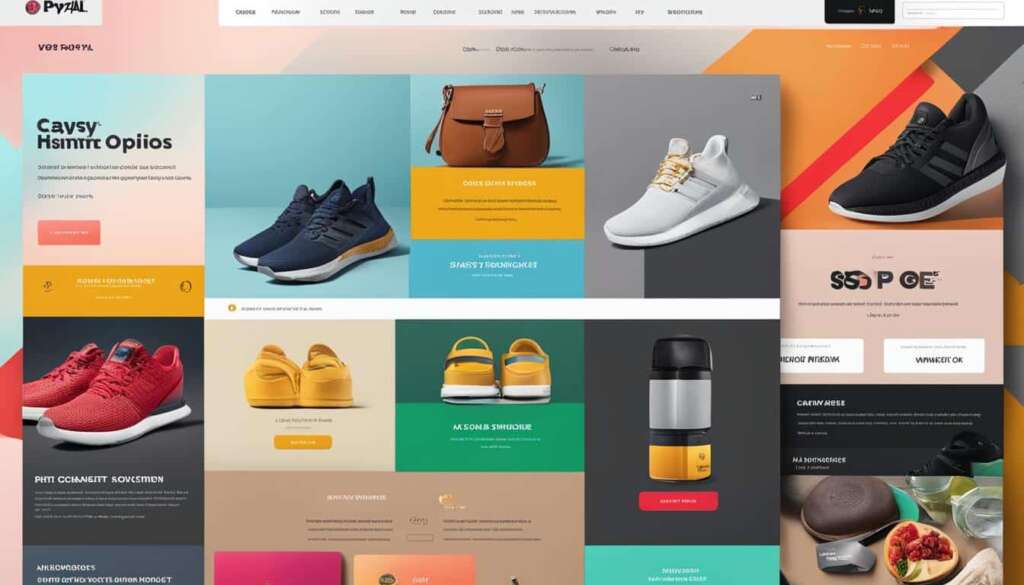Table of Contents
Your website design influences 75% of your store’s credibility, and you have less than one second to leave a first impression. E-commerce website design involves creating and launching a virtual store to sell products. Design for user experience, match brand identity, stay up-to-date with trends, optimize for mobile, incorporate customer reviews, simplify the checkout process, and incorporate trust signals.
Your e-commerce website design plays a crucial role in engaging customers and boosting sales. By embracing bespoke e-commerce website design, you can create a personalized online shopping experience that captivates your target audience. Implementing a visually appealing and user-friendly design will not only attract visitors but also encourage them to explore your products and make purchases.
Ecommerce Website Design Best Practices
Designing an ecommerce website involves implementing best practices to create a positive user experience, enhance brand identity, and drive conversions. By following these guidelines, you can ensure that your website engages customers and maximizes sales.
1. Design for User Experience
When designing your ecommerce website, prioritize user experience. Create a seamless and intuitive navigation system, making it easy for users to find products and navigate through different sections of the site. Use clear and concise language, and ensure that the important information is easily accessible.
2. Match Brand Identity
Develop a consistent and cohesive brand identity throughout your ecommerce website. Use your brand’s colors, typography, and imagery to create a visually appealing and memorable experience. Aligning your website design with your brand identity boosts recognition and trust among customers.
3. Stay Up-to-Date with Trends
Keep pace with the latest design trends in the ecommerce industry. Stay informed about emerging technologies, popular design elements, and user preferences. By incorporating modern design elements, you can create a visually appealing website that resonates with your target audience.
4. Optimize for Mobile
With the increasing number of users accessing websites through mobile devices, it is essential to optimize your ecommerce website for mobile browsing. Ensure that your website is responsive, meaning it adapts seamlessly to different screen sizes. This enhances the user experience and improves your website’s visibility in search engine results.
| Benefits of Mobile Optimization |
|---|
| Improved user experience |
| Higher search engine rankings |
| Increase in mobile conversions |
5. Incorporate Customer Reviews
Integrate customer reviews and testimonials into your ecommerce website design. Displaying genuine feedback and ratings builds trust and credibility, encouraging potential customers to make a purchase. Highlighting customer reviews prominently on product pages can significantly impact buying decisions.
6. Simplify the Checkout Process
A streamlined and user-friendly checkout process is crucial for reducing cart abandonment and boosting conversions. Minimize the number of steps required to complete a purchase, offer guest checkout options, and provide clear guidance throughout the process. Implement automatic address lookup and offer multiple payment options for added convenience.
7. Incorporate Trust Signals
Include trust signals throughout your ecommerce website to instill confidence in potential customers. Display security badges, encryption information, and guarantees prominently to reassure customers that their personal information is secure. Additionally, showcase industry certifications and partner logos to build trust and credibility.
“By following best practices in ecommerce website design, you can create a visually appealing, user-friendly, and trusted online shopping experience that drives conversions and builds customer loyalty.”
Remember, designing an ecommerce website is a continuous process. Regularly analyze user behavior, gather feedback, and make iterative improvements to refine your website’s design and enhance the overall user experience.
Creating a User-Friendly Homepage
The homepage plays a crucial role in the success of an e-commerce website. It serves as the first point of contact for visitors and sets the tone for their entire browsing experience. To ensure a user-friendly homepage that captivates and converts, it is essential to optimize various elements and incorporate effective strategies.
Above-the-Fold Content
Above-the-fold content refers to the portion of the webpage that’s visible without scrolling. It is the first impression that visitors get and should be engaging and informative. By strategically placing attention-grabbing content, such as compelling headlines, striking images, and persuasive calls to action (CTAs), you can immediately capture visitors’ attention and encourage them to explore further.
Title Tags and Meta Descriptions
Title tags and meta descriptions are HTML elements that provide concise summaries of a webpage’s content to search engines and users. Optimizing these elements with relevant keywords and compelling descriptions boosts the website’s visibility in search engine results pages (SERPs) and entices users to click through. A well-crafted title tag and meta description can significantly influence click-through rates and drive organic traffic to your website.
Optimizing Images
Images are visually appealing and can enhance the browsing experience. When incorporating images on your homepage, it is crucial to optimize them for fast loading times and appropriately use alt tags to improve accessibility. High-quality, relevant images that align with your brand identity and product offerings can engage visitors and make a lasting impression.

Effective Calls to Action (CTAs)
CTAs are elements on a webpage that prompt users to take a specific action, such as making a purchase, signing up for a newsletter, or contacting customer support. Well-designed CTAs, strategically placed throughout the homepage, can direct users towards desired actions, increasing conversion rates. Clear, concise language, contrasting colors, and prominent placement are key factors to consider when creating effective CTAs.
Mobile Optimization
In today’s mobile-centric world, optimizing your homepage for mobile devices is essential. Mobile optimization involves creating a responsive design that adapts to different screen sizes and ensures seamless navigation and readability. With a growing number of users browsing and making purchases on mobile devices, neglecting mobile optimization can significantly impact user experience and conversion rates.
Contact Information
Displaying contact information, such as a phone number or email address, on the homepage instills trust and provides visitors with a means to reach out for inquiries or support. Transparently showcasing contact details helps customers feel secure in their interactions with your business and enhances the overall user experience.
Personalized Recommendations
Personalized recommendations offer a tailored shopping experience, suggesting products or content based on a user’s previous interactions. By using algorithms and data analysis, you can showcase relevant products or content on your homepage, increasing engagement and encouraging conversions. Personalized recommendations demonstrate that you understand your customers’ preferences and can provide them with relevant offerings.
Incorporating these key elements into your homepage design and optimization strategy sets the foundation for a user-friendly and conversion-focused e-commerce website.
The Importance of A/B Testing
A/B testing plays a crucial role in optimizing an e-commerce website. By conducting thorough A/B tests, you can gather valuable insights and make data-driven decisions to improve your website’s performance and conversion rate.
A/B testing allows you to compare and analyze different versions of your website with slight variations in design, content, or functionality. This process helps you identify the most effective elements that drive user engagement and conversions. Whether it’s testing different CTAs, optimizing for mobile devices, or fine-tuning your SEO efforts, A/B testing enables you to optimize various aspects of your website and maximize its potential.
“A/B testing allows you to test different elements and strategies to determine which ones yield the best results.”
One area where A/B testing can have a significant impact is your call-to-actions (CTAs). By testing different variations of CTAs, such as button colors, text, or placement, you can identify the most compelling options that drive clicks and conversions. This can ultimately enhance the user experience and increase your website’s overall performance.
Another aspect to consider is mobile optimization. With the growing number of users accessing websites through mobile devices, it’s crucial to ensure a seamless mobile experience. A/B testing can help you determine the optimal layout, navigation, and content placement for mobile users, improving their engagement and conversion rates.
Your SEO efforts can also benefit from A/B testing. By testing different strategies, such as meta descriptions, title tags, or keyword placement, you can identify the approaches that generate the highest organic traffic and improve your website’s visibility in search engine results.
Conducting A/B tests should be an ongoing process in your optimization strategy. As you gather data and insights from these tests, you can continuously refine your website and adapt to the evolving needs and preferences of your target audience.
Key Takeaways:
- A/B testing is essential for optimizing an e-commerce website and driving conversions.
- It allows you to test different elements and strategies to determine the most effective options.
- A/B testing can improve various aspects, including CTAs, mobile optimization, and SEO efforts.
- By conducting A/B tests, you can make data-driven decisions and continuously optimize your website.
Benefits of A/B Testing
| Benefits | Explanation |
|---|---|
| Optimization | Improve website performance and conversion rate |
| Data-driven decisions | Make informed choices based on user behavior and preferences |
| Identification of best practices | Discover the most effective elements and strategies |
| Continuous improvement | Adapt and refine your website based on ongoing testing |
The Growth of E-Commerce and the Need for Optimization
The e-commerce market has witnessed significant growth, especially with the surge in online shopping during the pandemic. As more businesses venture into the e-commerce space, the need for optimization becomes crucial to stay competitive and maximize growth.
One of the key areas for optimization is the homepage of your e-commerce website. A well-optimized homepage is essential to attract and convert visitors into customers. By implementing homepage optimization strategies, you can create a compelling first impression, engage users, and drive conversions.
To effectively optimize your homepage for success, it is important to continuously experiment and test different strategies. Through this continuous experimentation, you can identify what works best for your target audience and adapt your SEO strategy accordingly.
Experimentation can involve testing various elements such as layout, content placement, color schemes, and call-to-action (CTA) buttons. By analyzing the results and gathering data, you can make informed decisions to enhance your homepage and improve user experience.
Implementing a continuous experimentation approach ensures that your optimization efforts are dynamic and adaptable to the evolving e-commerce market. This proactive strategy allows you to stay ahead of the competition and deliver a seamless online shopping experience to your customers.
Optimization is an ongoing process in the e-commerce world. By continuously experimenting and refining your strategies, you can unlock the full potential of your website and drive sustainable growth in the highly competitive online market.
The Benefits of Continuous Experimentation
Continuous experimentation offers several advantages, including:
- Improved Homepage Performance: By testing different elements, you can identify and implement changes that enhance the performance of your homepage, resulting in higher conversion rates.
- Enhanced User Experience: Experimenting with various design elements and user interface features allows you to fine-tune your website to provide a seamless and enjoyable user experience.
- Optimized SEO Strategy: Continuous experimentation enables you to identify and implement the most effective SEO strategies for your e-commerce website, driving organic traffic and visibility.
- Competitive Edge: By staying proactive and constantly testing new ideas, you can differentiate your brand from competitors and stand out in the crowded e-commerce market.

| Key Benefits of Continuous Experimentation | Description |
|---|---|
| Improved Homepage Performance | Testing different elements and implementing changes that enhance the performance of your homepage, resulting in higher conversion rates. |
| Enhanced User Experience | Experimenting with various design elements and user interface features to provide a seamless and enjoyable user experience. |
| Optimized SEO Strategy | Identifying and implementing the most effective SEO strategies for driving organic traffic and increasing visibility. |
| Competitive Edge | Differentiating your brand from competitors and standing out in the crowded e-commerce market. |
Conclusion
Optimizing your e-commerce website design is paramount for success in the competitive online market. By prioritizing user experience, implementing best practices, and conducting A/B testing, you can enhance your website’s conversion rate and foster growth. As the e-commerce market continues to evolve, continuous optimization is essential to stay ahead of the competition and deliver an exceptional online shopping experience for your customers.
Creating a visually appealing and user-friendly website design is just the beginning. By focusing on optimizing your e-commerce website, you can ensure that visitors are engaged and motivated to make a purchase. By following industry best practices such as mobile optimization, incorporating customer reviews, and streamlining the checkout process, you can improve the overall user experience and increase conversion rates.
A/B testing plays a crucial role in the optimization process. By experimenting with different strategies, you can gather valuable data and make informed decisions about elements like call-to-actions (CTAs), mobile optimization, and SEO efforts. This data-driven approach leads to continuous improvement and allows you to optimize your website’s performance in a highly competitive market.
As the e-commerce market continues to grow, optimization becomes even more crucial. By staying up-to-date with the latest trends, continuously testing and refining your website design, and providing a seamless user experience, you can not only drive growth but also establish a strong foothold in the competitive e-commerce market.
FAQ
What is e-commerce website design?
E-commerce website design involves creating and launching a virtual store to sell products online.
What are the best practices for designing an e-commerce website?
The best practices for designing an e-commerce website include focusing on user experience, matching brand identity, staying up-to-date with trends, optimizing for mobile, incorporating customer reviews, simplifying the checkout process, and incorporating trust signals.
How can I create a user-friendly homepage for my e-commerce website?
To create a user-friendly homepage, you should consider above-the-fold content, optimizing title tags and meta descriptions, optimizing images, implementing effective calls to action (CTAs), optimizing for mobile, displaying contact information, and incorporating personalized recommendations.
What is the importance of A/B testing for my e-commerce website?
A/B testing allows you to test different elements and strategies on your e-commerce website to determine which ones yield the best results. This can include optimizing CTAs, mobile optimization, SEO efforts, and more.
Why is website optimization important in the e-commerce market?
With the growth of the e-commerce market and increasing competition, website optimization is crucial to attract and convert visitors. Continuously experimenting and testing different strategies will help ensure your homepage is optimized for success in the competitive e-commerce market.
How can I optimize my e-commerce website design?
To optimize your e-commerce website design, you should focus on user experience, follow best practices, and conduct A/B testing to make data-driven decisions. Ongoing optimization is necessary to stay ahead of the competition and provide an exceptional online shopping experience for your customers.







